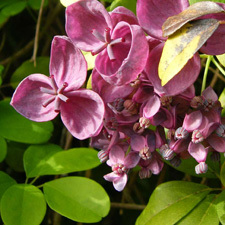 Chocolate vine
Chocolate vine
Common name: Chocolate vine
Botanical name: Akebia quinata
Management programme: Sustained control - Rule 5a applies
Where is it originally from?
Originates in Japan, China, and Korea, it was given the name chocolate vine due to its fragrant vanilla or chocolate scented flowers.
Why is it a pest?
Grows rapidly, forming a thick, smothering mat that prevents establishment of seedlings and native plants.
Where is it found?
Chocolate vine spreads via stem fragments and bird-dispersed seeds. It is tolerant to a wide range of conditions but prefers riparian zones, forest edges, wetlands, and urban areas.
There are no known sites in the Bay of Plenty.
What does it look like?
- Climber with slender stems that are green when young, turning brown as they mature.
- Leaves are often described as ‘hand-shaped’ with a purple tinge that becomes blue-green when mature.
- Clusters of brown-purple flowers with a vanilla fragrance from August to October.
- Fruits are purple-violet flattened sausage-like pods.
What are the rules?
Sustained control
Sustained Control pests are well established in the region and preventing the spread is no longer a realistic objective. Management focuses on reducing general impacts of the pest. Landowners/occupiers are responsible for the control of these pest species on their land. Council may enforce control.
Under rule 5a of the RPMP landowners/occupiers must destroy this pest if required by a written direction from an authorised person unless a property specific pest management agreement has been agreed and signed between the occupier and the Council.
Criteria to meet Rule 5A include when the species is being actively managed by council, other agency and or community group, on an adjacent property. See the Regional Pest Management Plan 2020-2030 rules for Sustained control pests for more information.
How do you get rid of it?
Recommended:
- Dig out individual vines, ensuring all roots are removed
- Cut stems (spring – summer) and paste with herbicide gel
- Large infestations can be foliar sprayed (spring – summer). Ensure complete leaf coverage is low. This method is most suitable for larger vines where the level of risk to desirable plants is low.
CAUTION: When using any herbicide or pesticide, PLEASE READ THE LABEL THOROUGHLY to ensure that all instructions and directions for the purchase, use and storage of the product, are followed and adhered to.
Read more on pest control advice, information and regulations.
Images








